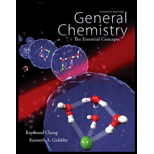
Concept explainers
(a)
Interpretation:
Need to calculate the amount of copper deposited and current needed to electrolyze the cell containing CuCl2 connected in series with the cell containing AgNO3.
Concept introduction:
In the given case two electrolytic cell containing AgNO3 and CuCl2 were connected in series, so the quantity of electricity flowing through both of the cell will be same
Half-cell reaction for cell-1 was given below.
The amount of the silver deposited was given, from which the amount of electricity flows though both of the cell can be calculated in steps. Number of moles of silver deposited was calculated first. Since one mole of electron is needed to reduce one mole of Ag+. Therefore number of moles of electron is equal to number of moles of sliver. The coulombs of electron passing can be calculated by the equation given below.
Half-cell reaction for cell-2 was given below.
Since they are connected in series, same amount of charges will be passing through both the cell. From the calculated charges the number of moles of electrons utilized can be calculated.
From the cell reaction it was known that two mole of electron will be needed to produce one mole of copper,
So
Since time was given the amperes of current flowing through the circuit can be calculated by the equation given below
To find: The amount of copper deposited and current consumed in a CuCl2 cell connected in series with the cell containing AgNO3.
(b)
Interpretation:
Need to calculate the amount of copper deposited and current needed to electrolyze the cell containing CuCl2 connected in series with the cell containing AgNO3.
Concept introduction:
In the given case two electrolytic cell containing AgNO3 and CuCl2 were connected in series, so the quantity of electricity flowing through both of the cell will be same
Half-cell reaction for cell-1 was given below.
The amount of the silver deposited was given, from which the amount of electricity flows though both of the cell can be calculated in steps. Number of moles of silver deposited was calculated first. Since one mole of electron is needed to reduce one mole of Ag+. Therefore number of moles of electron is equal to number of moles of sliver. The coulombs of electron passing can be calculated by the equation given below.
Half-cell reaction for cell-2 was given below.
Since they are connected in series, same amount of charges will be passing through both the cell. From the calculated charges the number of moles of electrons utilized can be calculated.
From the cell reaction it was known that two mole of electron will be needed to produce one mole of copper,
So
Since time was given the amperes of current flowing through the circuit can be calculated by the equation given below
To find: The amount of copper deposited and current consumed in a CuCl2 cell connected in series with the cell containing AgNO3.
Want to see the full answer?
Check out a sample textbook solution
Chapter 19 Solutions
Package: General Chemistry with Connect 2-year Access Card
 ChemistryChemistryISBN:9781305957404Author:Steven S. Zumdahl, Susan A. Zumdahl, Donald J. DeCostePublisher:Cengage Learning
ChemistryChemistryISBN:9781305957404Author:Steven S. Zumdahl, Susan A. Zumdahl, Donald J. DeCostePublisher:Cengage Learning ChemistryChemistryISBN:9781259911156Author:Raymond Chang Dr., Jason Overby ProfessorPublisher:McGraw-Hill Education
ChemistryChemistryISBN:9781259911156Author:Raymond Chang Dr., Jason Overby ProfessorPublisher:McGraw-Hill Education Principles of Instrumental AnalysisChemistryISBN:9781305577213Author:Douglas A. Skoog, F. James Holler, Stanley R. CrouchPublisher:Cengage Learning
Principles of Instrumental AnalysisChemistryISBN:9781305577213Author:Douglas A. Skoog, F. James Holler, Stanley R. CrouchPublisher:Cengage Learning Organic ChemistryChemistryISBN:9780078021558Author:Janice Gorzynski Smith Dr.Publisher:McGraw-Hill Education
Organic ChemistryChemistryISBN:9780078021558Author:Janice Gorzynski Smith Dr.Publisher:McGraw-Hill Education Chemistry: Principles and ReactionsChemistryISBN:9781305079373Author:William L. Masterton, Cecile N. HurleyPublisher:Cengage Learning
Chemistry: Principles and ReactionsChemistryISBN:9781305079373Author:William L. Masterton, Cecile N. HurleyPublisher:Cengage Learning Elementary Principles of Chemical Processes, Bind...ChemistryISBN:9781118431221Author:Richard M. Felder, Ronald W. Rousseau, Lisa G. BullardPublisher:WILEY
Elementary Principles of Chemical Processes, Bind...ChemistryISBN:9781118431221Author:Richard M. Felder, Ronald W. Rousseau, Lisa G. BullardPublisher:WILEY





